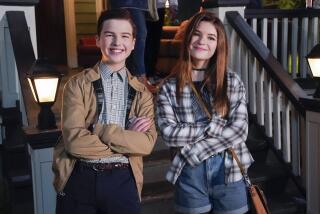Thursday rules
- Share via
You can picture yourself in a high-seated SUV, bouncing across a red-rock arroyo, can’t you? You want all the high-seas harvest that Red Lobster can offer spread out before you. You want to feel the chill of a stadium-seat movie house while Colin Farrell SWATs away evildoers on screen.
The TV networks deliver such crystalline commercial thoughts into viewers’ heads every Thursday night through advertisements that gear the brain for the weekend ahead. You can do it all -- test drive your fantasy vehicle, then drift into feast and film. And the breaks between mega-promoted series instruct as to how and where to fulfill these wishes.
So how did all 103 million of us get there on the same night? The answer is that we were lured through a clever collaboration. Networks, which needed one night of concerted competition to create some magic, joined with advertisers, who wanted the wealthiest, youngest and most discerning consumers served up just as the workweek wound down. If consumption drives our lives, then at no time is the consumable bounty offered up more completely and aggressively than on Thursday-night television. And it is not because more Americans are watching -- Monday night wins, if measured in total faces staring into the TV glow, on average. But on Thursday, “the young audience is watching television,” says David Poltrack, a CBS planning executive. “And advertisers will pay what it costs to be there.”
This season will be the biggest battle yet for Thursday-night brain space. Ever since NBC first established its comedy-led franchise with “The Cosby Show” in 1984, the Peacock Network has had a near lock on the night. For two decades, the laughs kept coming (“Family Ties,” “Cheers,” “Seinfeld,” “Friends,” “Will & Grace”) and led into dramatic night-cappers like “Hill Street Blues,” “L.A. Law” and “ER.” Then each of the last three seasons, CBS has added a blockbuster to its Thursday-night lineup, and the summer’s rerun ratings surge for “Without a Trace” gives the network a three-hit, anti-NBC phalanx, which also includes “Survivor” and “CSI.”
But before Thursday could rise, a major night of TV watching had to be dismantled. Saturday night used to be an evening of maximum programming energy, even if the number of people watching was never as high as on Sunday or Monday nights. “Saturday night has always been a relatively lower viewing night, but it could be profitable for networks when they were controlling all the audience,” explains Poltrack. His network put some of its crowd pleasers -- “All in the Family,” “The Mary Tyler Moore Show,” “The Bob Newhart Show” and “The Carol Burnett Show” -- right there in a night of stay-at-home, appointment television.
The entertainment consumer back then, in the 1970s, basically had two weekend options: go out to a movie or stay at home to see what the networks had to keep you from doing so. In some cases, a network could let you do both, in a way, by showing a first television run of some major film. “That was a big event,” explains Preston Beckman, Fox’s chief scheduler. But then HBO started offering the same kind of TV premieres, at a premium but without ads. And then VCRs gave viewers another movie-at-home option. Eventually, advertiser-supported cable and upstart networks all began to steal away their respective parts of the stay-at-homes.
In the ‘80s, advancements in ratings technology had let the networks know that the only sectors watching in big numbers were youngsters and oldsters -- viewers of “The Facts of Life” and “Golden Girls,” respectively. Eventually “The Love Boat” sank as a weekend favorite and networks bailed on Saturday, where the lone remaining franchise was “Saturday Night Live,” the late-night hit that still outpaces any network offering in prime time that evening.
If first runs of movies helped undo Saturday night, movie marketing budgets were a boon for Thursday-night tube-watching. “The movie has just two weekends to make it,” says CBS’ Poltrack. “The young audience is watching television then. This is the time to get them, and it’s a must-buy.” “On Thursday night, everything comes together,” says Mitch Metcalf, NBC’s planning executive. At one point, NBC’s Thursday-night profits climbed to a level greater than each of the other networks’ profits for their entire prime-time lineups. And CBS’ reality contest and procedural crime dramas have wowed -- and widened -- the Thursday-night crowd.
To get a sense of the monetary stakes involved, last season’s highest-priced ad was sold during CBS’ “Survivor” for $456,000 per 30-second spot, according to industry estimates. This is compared to the Saturday-night bargain price of ads sold along with Fox’s “Cops,” which went for $49,000, according to the experts. On a good Thursday night, NBC rakes in more than $18 million in ad revenue, according to some estimates, compared to roughly $3 million on a Saturday.
There’s only one catch for the networks: As the stakes have climbed steadily higher, savvy casts, crews and studios demanded more to keep the show running.
“Seinfeld,” “Friends” and “ER” all went through high-profile negotiations to extend their runs, with fattened wallets for creative types at each deal’s end. For NBC, the new contracts trimmed profits to lower but still enviable levels. Now, CBS is in the early and thus more profitable stage of its nascent Thursday enterprise. “We make more money on Thursday night than NBC,” asserts Poltrack of CBS. And the reason is simple: “Our shows cost less.”
The “Friends” run is ending after 18 new episodes this year, with a Joey Tribbiani spinoff set to pick up after the clique disbands in 2004. But that uncertainty hurts the Peacock Network: Can it keep the show’s magic alive with just one-sixth of its cast? And the handoff arrives right when TV’s onetime top drama, “ER,” is coming off what sports teams would call a “rebuilding season.” That means other networks will step up efforts to follow CBS’ lead in luring away viewers and ad dollars.
Fox has moved to Thursday its summer hit “The O.C.,” hoping to peel off some of “Friends’ ” young female fans, just as UPN continues to attract male teens with its “WWE Smackdown!” on that night. ABC has a cheaper and ghastly option with its “Extreme Makeover” reality show also airing in the key 9 p.m. slot. “I think you can get people to watch in huge numbers on any night,” says Fox’s Beckman. “All it takes is for one show to pop, and then a network can build a night around it.” But moving massive numbers of Americans out of this multidecade viewing pattern is an unlikely shift, even if the economy slumps and creates a nation of penny-pinching shut-ins or even if TiVo and on-demand devices make scheduled viewing obsolete for millions.
Too many economic forces have us where they want us: planted at home as part of the world of commerce’s most desired demographic confluence. “The historical notion that Saturday and Friday are lower viewing nights is going to be a fact for as long as we have to think about it,” Beckman says. It’s a multibillion-dollar launch pad sending us into a weekend orbit of buying. And networks and advertisers will prize this platform as much as we prize our freedom to heed -- or ignore -- their spending suggestions on the weekend that follows.
More to Read
The complete guide to home viewing
Get Screen Gab for everything about the TV shows and streaming movies everyone’s talking about.
You may occasionally receive promotional content from the Los Angeles Times.






